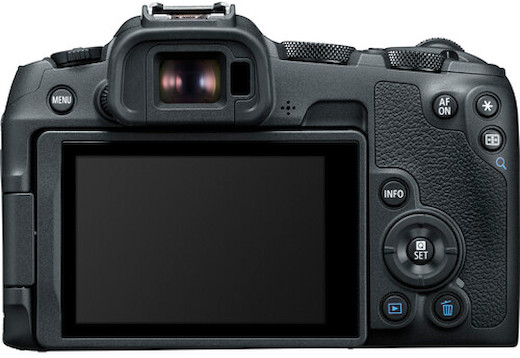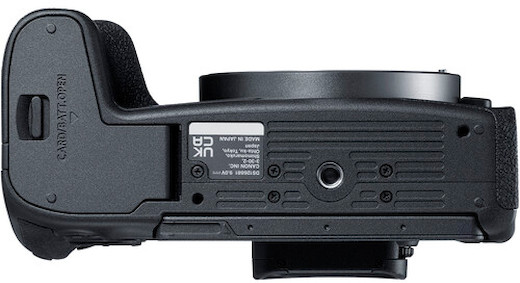The Canon EOS R8 is a full-frame prosumer mirrorless camera that offers UHD 4K 60 fps video capture, 40 fps continuous still shooting with the silent electronic shutter, advanced autofocus, and 5-axis movie image stabilization. Key features include:
24.2MP full-frame CMOS sensor; DIGIC X processor
4K60p 10-bit internal video; Canon Log 3
Livestreaming-capable without additional software
5-axis movie image stabilization; dual-pixel autofocus
What’s Changed? Rather than being a direct successor to the EOS R7, the Canon EOS R8 essentially combines the body design of the entry-level EOS RP with the sensor and autofocus system from the higher-end EOS R6 Mark II. That said, the absence of a mechanical first-curtain shutter means the R8 can’t seriously compete with the still-shooting speeds found in higher-end cameras.
24.2MP Full-Frame Sensor and DIGIC X Processor. The EOS R8’s 24.2MP full-frame stacked CMOS sensor works in tandem with the DIGIC X processor to produce high-resolution stills and video with a fair amount of speed. Its back-illuminated design lets in plenty of light, giving you reduced noise, high clarity, and smooth color rendering, even when you’re shooting in low light. The native ISO range of 100-102,400 can be expanded to 100-204,800, making this camera suitable for working in a wide range of lighting conditions.
High-Quality Still Shooting. The R8 supports up to 40 fps continuous shooting with a silent electronic shutter and 6 fps with an electronic first-curtain shutter with autofocus and autoexposure readings between each frame. A 30 fps RAW burst mode gives you the option of capturing frames up to a half-second before you press the shutter release, and includes all the shots from each burst under a single thumbnail designated by a special icon.
UHD 4K Video Capture. The EOS R8’s 24.2MP sensor lets you capture UHD 4K RAW video at up to 60 fps using the sensor’s full width, and lets you work with 10-bit sampling using Canon Log 3. You can also get oversampled 4K video at 60 fps from a 6K recording area for greater sharpness, less noise, and reduced moiré. There’s 180p recording at up to Full HD resolution for slow-motion playback, and there’s a HDR-PQ recording option for in-camera HDR production and external recording via the micro-HDMI port, which outputs clean 4K at up to 60 fps. Finally, audio in and out are available through standard 3.5mm jacks for both microphones and headphones.
Livestreaming. The R8’s UVC/UAC compatibility means you can use it as a webcam to stream live video in Full HD to video-conferencing software like Zoom, Skype, and Microsoft Teams without the need for additional software. The full-frame image sensor gives you versatile exposure options in addition to strong subject-background isolation when using bright-aperture lenses.
Movie Digital Image Stabilization. The five-axis Movie Digital IS system keeps your footage steady while you’re shooting hand-held. You can further reduce camera-shake by using an RF lens equipped with optical image stabilization.
Dual-Pixel CMOS Autofocus II. This camera incorporates a Dual-Pixel CMOS Autofocus II system almost identical to the one seen in the EOS R6 Mark II. Its 1,053 automatic autofocus points cover 100% of the image frame to give you smooth, fast, accurate focusing similar to what you’d find on a camcorder, while its use of Deep Learning tech gives you improved subject tracking and more precise eye, face, and head detection. There are subject-tracking modes designed to follow humans, animals, and vehicles, while a new Auto mode uses a combination of all the subject-tracking modes to automatically apply the best algorithm to the subject you’re shooting. Movie Servo AF mode lets you dictate tracking sensitivity, autofocus speed, and face-tracking priority, and video shooters can even use the rear touchscreen LCD to rack focus. If you’re shooting a subject that disappears from the frame, the new video-only Detect-Only mode instructs the camera to leave focus where the subject left off instead of trying to lock onto a new subject.
Body Design. The large OLED live viewfinder has a 2.36m-dot resolution, 0.70x magnification, and 120 fps refresh rate that make it great for easy eye-level composition. The 3.0-inch, 1.62m-dot rear touchscreen LCD monitor allows you to pull focus in video mode and make quick adjustments in the camera’s menu system, while its vari-angle design makes it great for vlogging and other front-facing recording applications, and for shooting at high and low angles. A tank-like build and weather sealing keep out the elements and dust.
Next-Gen Multi-Function Shoe. This camera’s next-gen Multi-Function Shoe is an update to the conventional hot shoe that adds a row of pins at the front to give you expanded accessory functionality and to power certain accessories that typically need separate batteries. You can use the Canon AD-E1 Multi-Function Shoe Adapter to use select legacy shoe-mounted accessories, such as the Canon ST-E3-RT Speedlite Transmitter – V2 and Canon Speedlite EL-1, with the shoe.
Built-In Bluetooth and Wi-Fi. Integrated Bluetooth and Wi-Fi let you use Canon’s Camera Connect app to instantly transfer images to your mobile device so that you can easily share them on social media, in email, and to the cloud. You can also use it to shoot remotely, livestream, and to remotely control the camera. There are also wired connectivity options, and this camera includes a remote port, a USB-C port, a micro-HDMI port, a microphone input, and a headphone jack.
User Flexibility. The R8 records images/video to UHS-II SD memory cards (not included) for broad compatibility in a familiar format, but please be aware that it only has one memory-card slot. The camera is powered by the popular LP-E17 rechargeable lithium-ion battery.














